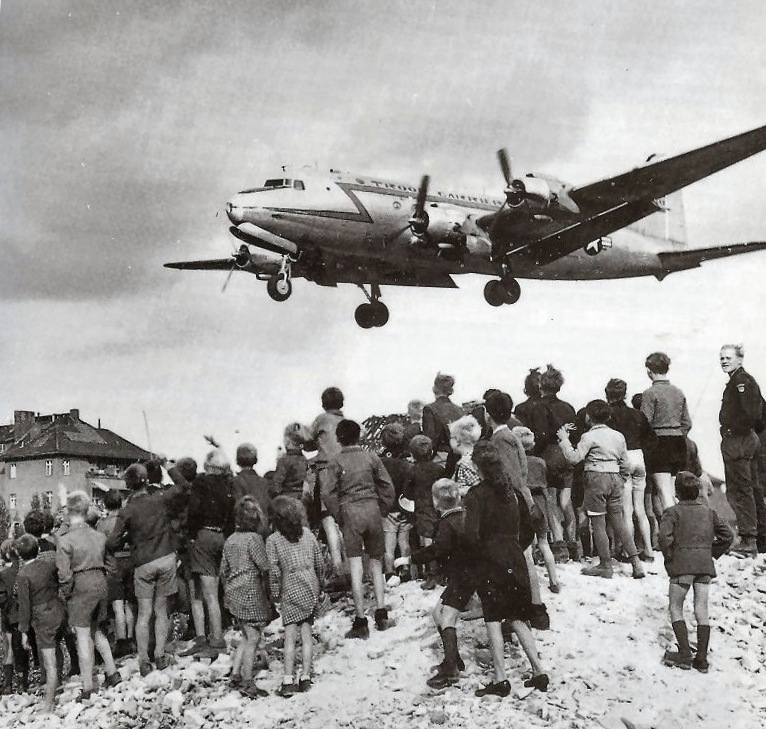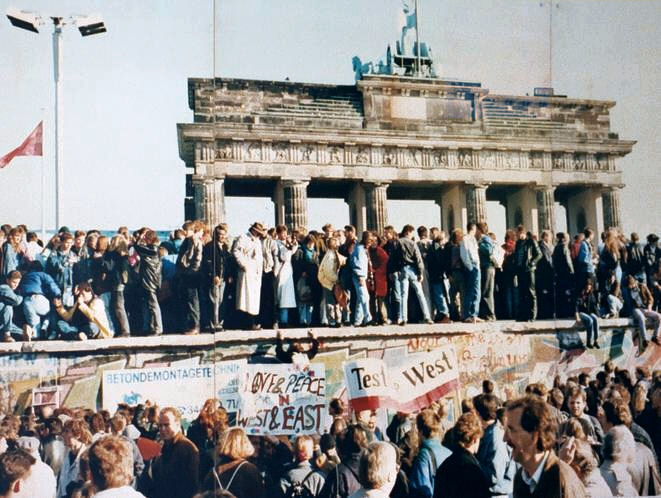Articles
- The 20th century
- Key events
- Making sense of the tangible world
- Health and Welfare
- Space exploration
- Scientific advancement: computers, technology & textiles
- Monarchy
- Democracy & social mobility
- Transport and leisure
- Colonialism & post-colonialism
- Sexuality, marriage, parenthood & divorce
- Income & consumerism
- Humans and the environment
- Educational context
- Mass culture & entertainment
- The world of work
- Making sense of the intangible world
From the Berlin Airlift to the fall of the Berlin Wall
The aftermath of the Second World WarTension among the wartime alliesThe Berlin blockade and airliftGermany dividedThe Berlin wallThe fall of the Berlin wallGermany reunited
The aftermath of the Second World War
When the Second World War ended, Germany was divided into four zones. The United Kingdom, France, the United States and the Soviet Union each controlled a zone. Germany's capital city, Berlin, was in the Soviet zone. Since it was the capital, the city itself was divided into four zones. The British, French and Americans were allowed to use roads, canals, railways and air space through the Russian zone to get to Berlin.
Tension among the wartime allies
Despite accords at the end of the war, relations between the Soviet Union, under the leadership of Stalin, and her wartime allies - the United Kingdom, the United States and France - quickly deteriorated. The three western countries wanted to help Germany recover from the war, so that it would not want to seek revenge against them in the future (as had happened after the First World War). The Soviet Union, by contrast, wanted to treat its part of Germany as conquered land under Soviet control.
The Berlin blockade and airlift
 In 1948, the Soviet Union closed the road, rail and canal links between the western zones of Germany and Berlin. It was trying to drive the western countries out of Berlin. They, in turn, organised an airlift of supplies to the western-controlled parts of Berlin. Over a period of ten months, hundreds of air flights kept the western zones of Berlin supplied with their basic needs. Eventually, in 1949, the Soviet Union called off the blockade.
In 1948, the Soviet Union closed the road, rail and canal links between the western zones of Germany and Berlin. It was trying to drive the western countries out of Berlin. They, in turn, organised an airlift of supplies to the western-controlled parts of Berlin. Over a period of ten months, hundreds of air flights kept the western zones of Berlin supplied with their basic needs. Eventually, in 1949, the Soviet Union called off the blockade.Germany divided
From 1949 onwards, Germany became two separate countries:
- The British, French and American zones became the German Federal Republic, more commonly known as West Germany. West Berlin was part of the Federal Republic, although it was separate from it.
- The Soviet zone became the German Democratic Republic, often referred to as East Germany.
The two countries reflected the differences between the nations which had controlled them when the Second World War ended:
- The Federal Republic was a democracy with a free market economy. With the help of foreign loans, it developed a strong economy and became prosperous.
- The Democratic Republic was a one-party Communist state, where standards of living were much lower than in the Federal Republic. It had its own government but was very much under the control of the Soviet Union.
The Berlin wall
The late 1940s and the 1950s were the early years of the Cold War. Germany was a particular focus of tension, as it was one of the places where the two sides shared a border.
Because life in West Germany was more prosperous than in East Germany, many East Germans crossed from East to West Berlin. From there, they could travel to live in West Germany and other Western European countries. In 1961, the East German government tried to stop this by building a wall around West Berlin. It completely cut all land links between West Berlin and the rest of the city and the Democratic Republic. Between 1961 and 1989, the wall prevented almost all attempts by East Germans to escape to the West. An unknown number (possibly around 200) were killed in trying to do so.
The fall of the Berlin wall
 In 1989, throughout the Eastern European countries controlled by the Soviet Union since the Second World War, there was growing unrest. People wanted greater political and economic freedom, such as people in Western European countries already enjoyed. The unrest spread to East Germany and the East German government announced that East German citizens were free to visit West Berlin and West Germany. People began to chip away parts of the wall and, in 1990, its formal demolition began.
In 1989, throughout the Eastern European countries controlled by the Soviet Union since the Second World War, there was growing unrest. People wanted greater political and economic freedom, such as people in Western European countries already enjoyed. The unrest spread to East Germany and the East German government announced that East German citizens were free to visit West Berlin and West Germany. People began to chip away parts of the wall and, in 1990, its formal demolition began.Germany reunited
In 1990, East and West Germany came together to form the single nation of Germany, which adopted the characteristics of West Germany. Following heavy internal investment the unified country steadily prospered, to become the strongest nation in Europe, both politically and economically.
The global war which lasted from 1939 – 1945
The Union of Soviet Socialist Republics (USSR) shortened to the Soviet Union.
Communist leader of the Soviet Union from 1924 until his death in 1953.
World War I, also know as the First World War and the Great War, was a global conflict from 1914 – 1918, centred in Europe, involving all the world’s major economic powers in two opposing alliances.
When a place is sealed off by troops or ships.
Rule by the demos or people
An economic system whereby companies are controlled by private individuals and business takes place without government interference or control.
An economic ideology based on gaining common ownership of the means of production. This is achieved by political revolution and social engineering; a communist is a followed of this ideology.
The Union of Soviet Socialist Republics (USSR) shortened to the Soviet Union.
The so-called Cold War, 1945 - 1990, between the United States of America and Soviet Russia and their respective allies.
